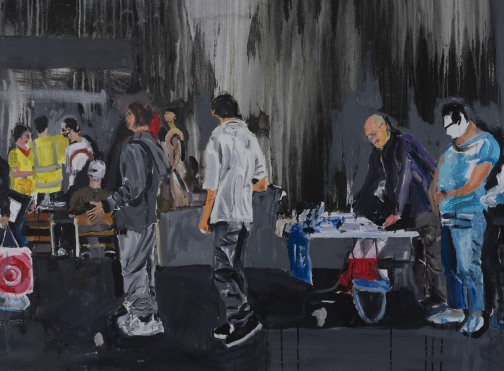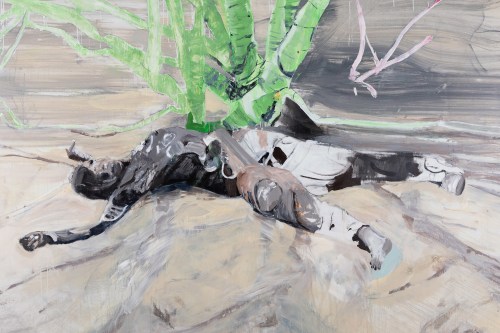

An epidemic is quietly transpiring throughout the USA. Indigenous peoples and immigrants have struggled with high rates of assault, abduction, and especially murder of women. Native American and Alaska Native community advocates describe the crisis as a legacy of generations of government policies of forced removal, land seizures and violence. These cases far too often go unsolved, leaving grieving families to investigate on their own. The exhibition law of the land presents a selection of paintings from two of Brian Maguire’s recent bodies of work: Missing and Murdered Indigenous People (M&MIP), and The Remains, Arizona. Both series depict scenes of murdered or missing individuals from Montana and Arizona, representing the voices of marginalized groups whose stories are not widely disseminated. Maguire reacts to this violence by memorializing the victims and sharing their fates. His investment in social activism stems from his involvement in the civil rights movement of Northern Ireland in the 1970s. Since the very beginning of his artistic career, he has approached painting as an act of solidarity, drawing him to marginalized people and alternative spaces such as prisons, women’s shelters, and psychiatric institutions. In recent years, Maguire’s work has become increasingly focused on lives lost, often with a political perspective on the event of the loss.
In the state of Montana, in the northwest of the United States, thousands of indigenous people are missing. Especially young women are disappearing or being found murdered. The series Missing and Murdered Indigenous People (M&MIP) was initiated while Maguire participated in a residency at the Missoula Art Museum in Montana. Through a series of meetings and other engagements between indigenous organizations from the Blackfoot and the Salish tribes, the artist and some of the deprived local families agreed to begin a series of memorial portraits to express their tribulations. Maguire’s acrylic paintings are rendered from photographs that family members have selected. Based on their stories, he produces intimate renditions aiming to capture the likeness and spirit of the child. For every individual, two paintings are created: one for the family as a keepsake, and one for public exhibitions. Throughout history, people have made portraits in various forms to pay respect to a deceased person or to memorialize historically significant events. In western society memorial paintings have been especially popular among the aristocracy, whose likenesses still dominate museum collections today. The act showcasing the second copy is a way of shifting the power dynamics in this long-standing tradition by giving voice to marginalized and colonized peoples on the global art scene – the stronghold of differentiated visibility.
The largescale paintings in the series The Remains, Arizona, confront issues of migration and the dangers facing people who risk their lives when driven from their homelands. The works are based on police cellphone photos of deceased people found in the border region between USA and Mexico. The series is inspired by the contrast of public debate where migrants are depicted as a danger to society, and a reality where the “Law of our Land” causes danger to migrants. Since the dawn of time, most cultures have agreed that governing powers should treat people fairly. But justice and equality before the law in the course of human history has not been the main rule. To date, Maguire has worked with 16 out of the 90 police files on migrants he was given access to: “it is the death I record or memorialize,” the painter says, “no family would like to retain this image of a loved one, except as needed by a process of seeking justice.” The paintings presented at Kunsthall 3,14 are some of Maguire’s most nuanced and ambitious works to date, crafted with larger brushes and thinned-down acrylic on canvas. Working slowly with the photographic sources, he searches for that hard-to-find point where illustration ceases, and art begins. While directly referring to ongoing injustices faced by indigenous people and migrants in the USA, Maguire’s gestural paintings of skulls and bodies in the dirt simultaneously challenge the tradition of the landscape genre rooted in the era of romanticism, which closely connected to the enlightenment ideas that gave birth to the modern nation state.
The exhibition title law of the land is intended to challenge to the modern idea of the nation-state where law (understood as the right to exercise power) is thought of as a natural and obvious extension of land (understood as territory). As the depicted atrocities in both of series demonstrate, it is not a given that legal equality before the law ensures the same legal protection for all individuals. As in most of human history, minority voices are silenced or ignored.
Curator: Malin Barth